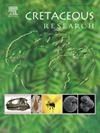Palaeoenvironmental inferences of a Mexican Konservat-Lagerstätte (Tlayúa Quarry; Lower Cretaceous) based on the geochemistry of rare earth elements
IF 1.7
3区 地球科学
Q1 GEOLOGY
引用次数: 0
Abstract
The Tlayúa Quarry is considered one of the most important Cretaceous outcrops in Mexico. Its well-preserved palaeobiota has allowed this outcrop to be considered a Konservat-Lagerstätte. Geochemical proxies such as major, minor and trace elements were evaluated from selected Zones of the Tlayúa Quarry, in order to infer some features of the depositional environment in which Tlayúa limestones originated. Aluminum, Thorium and Zirconium concentrations in addition to a low Phosphorous content evidence little terrigenous contamination, as well as a phosphate-free environment. Additionally, proxies such as Fe vs ΣREE, Mn vs ΣREE, Al vs ΣREE, Fe vs NdSN/YbSN, Al vs NdSN/YbSN, and Ce/Ce∗ vs Eu/Eu∗ show low correlation values (r2 less than 0.25 in all cases with n = 128 and p < 0.05), thus suggesting a negligible influence of diagenetic effects or terrigenous contamination. These conditions are necessary for carrying out reliable palaeoenvironmental interpretations. Rare Earth Elements + Yttrium (REE+Y) concentrations were normalised to the Post-Archean Australian Shale standard to evaluate REE+Y patterns and anomalies. Following traits were identified: a slightly enrichment of heavy REE relative to light REE and moderate REE; positive La/LaSN, Gd/GdSN and Y/YSN anomalies; negative/positive Ce/CeSN anomalies; superchondritic and chondritic Y/Ho ratios. Here, we described that most of our limestone samples show the influence of marine waters and well oxidising conditions. However, freshwater signals that have been reported for some regions of the Tlayúa Quarry were also verified. Geochemical data are in agreement with the depositional environment evidenced by microfacies.
基于稀土元素地球化学的墨西哥 Konservat-Lagerstätte(Tlayúa 采石场;下白垩统)古环境推论
Tlayúa 采石场被认为是墨西哥最重要的白垩纪露头之一。其保存完好的古生物群使该露头被认为是一个保护区(Konservat-Lagerstätte)。对 Tlayúa 采石场选定区域的主要元素、次要元素和微量元素等地球化学代用指标进行了评估,以推断 Tlayúa 灰岩起源的沉积环境的一些特征。铝、钍和锆的浓度以及较低的磷含量表明,这里几乎没有受到土著污染,也不存在磷酸盐环境。此外,铁与ΣREE、锰与ΣREE、铝与ΣREE、铁与NdSN/YbSN、铝与NdSN/YbSN、Ce/Ce∗与Eu/Eu∗等代用指标显示出较低的相关值(在所有情况下,r2均小于0.25,n=128,p <0.05),从而表明成岩作用或土著污染的影响可以忽略不计。这些条件是进行可靠的古环境解释所必需的。稀土元素+钇(REE+Y)浓度按照后雅典澳大利亚页岩标准进行归一化处理,以评估 REE+Y 模式和异常。确定了以下特征:重稀土元素相对于轻稀土元素和中等稀土元素略有富集;La/LaSN、Gd/GdSN 和 Y/YSN 正异常;Ce/CeSN 负/正异常;超软玉岩和软玉岩 Y/Ho 比率。在这里,我们描述了大部分石灰岩样本显示出海水和良好氧化条件的影响。不过,在 Tlayúa 采石场的某些区域也验证了淡水信号。地球化学数据与微地层所证明的沉积环境一致。
本文章由计算机程序翻译,如有差异,请以英文原文为准。
求助全文
约1分钟内获得全文
求助全文
来源期刊

Cretaceous Research
地学-地质学
CiteScore
4.10
自引率
19.00%
发文量
235
审稿时长
12 weeks
期刊介绍:
Cretaceous Research provides a forum for the rapid publication of research on all aspects of the Cretaceous Period, including its boundaries with the Jurassic and Palaeogene. Authoritative papers reporting detailed investigations of Cretaceous stratigraphy and palaeontology, studies of regional geology, and reviews of recently published books are complemented by short communications of significant new findings.
Papers submitted to Cretaceous Research should place the research in a broad context, with emphasis placed towards our better understanding of the Cretaceous, that are therefore of interest to the diverse, international readership of the journal. Full length papers that focus solely on a local theme or area will not be accepted for publication; authors of short communications are encouraged to discuss how their findings are of relevance to the Cretaceous on a broad scale.
Research Areas include:
• Regional geology
• Stratigraphy and palaeontology
• Palaeobiology
• Palaeobiogeography
• Palaeoceanography
• Palaeoclimatology
• Evolutionary Palaeoecology
• Geochronology
• Global events.
 求助内容:
求助内容: 应助结果提醒方式:
应助结果提醒方式:


